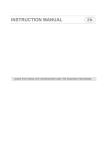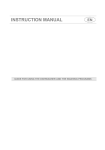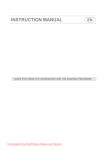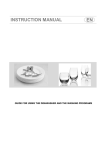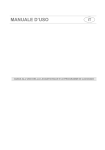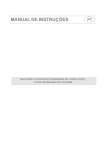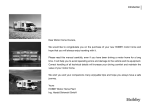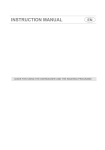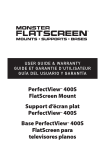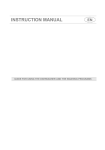Download Smeg DF4SS-1 dishwasher
Transcript
INSTRUCTION MANUAL GUIDE FOR USING THE DISHWASHER AND THE WASHING PROGRAMS Contents 1. 2. 3. 4. Description of the controls ________________________________ 2 Operating instructions ___________________________________ 15 Cleaning and maintenance _______________________________ 27 Troubleshooting _______________________________________ 32 Thank you for choosing one of our products. You are advised to read this manual carefully; it contains all the information you need use your dishwasher safely, correctly and in the most satisfactory manner. Following the cleaning instructions provided here will keep your dishwasher's performance at peak levels in the long term. USER INSTRUCTIONS: these consist of recommendations for using the appliance, a description of its controls and of the correct cleaning and maintenance procedures. 1 User instructions 1. Description of the controls 1.1 Upper panel All the dishwasher controls are grouped on the upper panel. Switching on, programming, switching off, etc. are only possible when the door is open. The panel shown is given as example: the form of the lights and buttons may vary depending on the model. 1 ON/OFF BUTTON Press this button to switch the dishwasher on/off. SELECTED PROGRAM INDICATOR LIGHTS 2 This light indicates the program selected and the occurrence of a fault (Troubleshooting). PROGRAM SELECTION BUTTON 3 + ADJUSTING THE WATER SOFTENING SYSTEM Used to select the wash program required and adjust the water softening system. WATER HARDNESS ADJUSTMENT ON INDICATOR LIGHT The light flashes to indicate that the appliance is in “water hardness 4 adjustment” mode. SALT WARNING LIGHT This light 5 6 2 Indicates the salt is finished. RINSE AID WARNING LIGHT This light indicates the rinse aid is finished. OPTIONS and DISPLAY (on some models only) User instructions INFORMATION DISPLAY (on some models only) Information displayed Program duration Remaining program time Delayed start: 1-24 hours Error message: Err <<OPTIONS (6)>> Depending on the model, this zone may contain the information display and one or more of the following options, identified by symbols and described in more detail later in the manual. All options except "Flexi Tabs" are disabled at the end of the wash cycle. To disable the “Flexi Tabs” option, press the button (the light goes out). Flexi Tabs Option recommended for the use of multi-function tablet detergent. HYCLEAN Removes bacteria more effectively by prolonging the last hot rinse. Spread HALF LOAD WASH Recommended for washing small loads spread across both baskets. PROGRAM DELAY Allows the start of the program to be delayed by 9, 12 or 24 hours depending on the model. QUICK TIME Select this option when a short wash program is required (see programs table). ENERSAVE Energy saving option. PROGRAMS TABLE The manual may include the programs table for several models. The set of symbols at the top of the table indicates the programs available for your dishwasher. 3 User instructions SWITCHING ON, SETTING STARTING THE PROGRAM • • • • THE WASHING PROGRAM AND Press the ON/OFF button (1); the PROGRAM INDICATOR LIGHT (2) will come on; Keep pressing the PROGRAM SELECTION button (3) until the indicator light for the required program lights up; Select the required option (if any, depending on models); Close the door and after about 2" the program will start; while it is running, the corresponding LIGHT will flash (program running indicator). PROGRAM IN PROGRESS INDICATOR LIGHT (on some models only) When a program is running, a flashing light is projected onto the floor under the right-hand corner of the door. At the end of the program, the light goes out to reduce stand-by electricity consumption. 4 User instructions PROGRAMS TABLE PROGRAMME NUMBER & SYMBOL 1 RAPID 27’ EN 50242 4 AUTO 45-65 5 SUPER PROGRAM PROGRESS MINUTES (1) WATER LITRES POWER kWh (1) Dishes with light dirt, washed immediately after use Wash at 38°C Rinse at 50°C 27 6,5 0,70 Glass, china and mixed dishes with light dirt. Wash at 45°C Cold rinse Rinse at 70°C Dry 59 12 0,90 Dishes with normal dirt, even with dried-on residues Hot prewash Wash at 45°C Rinse at 65°C Dry ** ** ** 2 GLASS 3 ECO (*) CONSUMPTION DURATION LOAD CROCKERY AND CUTLERY Pans and dishes with normal dirt, even with dried-on residues. When the "AUTO" program is selected, the dishwasher recognises the type of dirt and automatically adjusts the washing parameters as appropriate. Hot prewash Very dirty pans and Wash at 70°C dishes, even with dried-on Cold rinse (2) residues. Rinse at 70°C Dry 105 20 1,50 IMPORTANT: see “NOTES AND REFERENCES” table on the following pages. If the dishwasher door is open or not properly closed, the washing cycle will not start. Models with ENERSAVE option 3 ECO (*) EN 50242 Cold prewash Dishes with normal dirt, Wash at 45°C even with dried-on residues. Rinse at 55°C Dry ** ** ** 5 User instructions QUICK TIME PROGRAMS (see relevant section for explanation of functioning modes) PROGRAMME NUMBER E SYMBOL 6 SOAK + 7 DELICATE QUICK DURATION LOAD CROCKERY AND CUTLERY PROGRAM PROGRESS Pans and dishes awaiting completion of the load WATER LITRES POWER kWh (1) Cold prewash 9 5 0,02 Delicate dishes with normal dirt. Cold prewash Wash at 50°C Cold rinse Rinse at 70°C 53 12,5 1,15 Dishes with normal dirt, washed immediately after use. Cold prewash Wash at 60°C Cold rinse Rinse at 70°C 80 12,5 1,25 Dishes with normal dirt, washed immediately after use. Cold prewash Wash at 70°C Cold rinse Rinse at 70°C 85 13 1,40 Mixed dishes with normal dirt without dried-on residues. Wash at 65°C Cold rinse Rinse at 70°C 50 10 1,20 + 8 ECO QUICK + 9 NORMAL QUICK + 10 STRONG and FAST + CONSUMPTION MINUTI (1) IMPORTANT: see “NOTES AND REFERENCES” table on the following pages. If the dishwasher door is open or not properly closed, the washing cycle will not start. 6 User instructions PROGRAMS TABLE PROGRAMME NUMBER & SYMBOL 1 RAPID 27’ 2 AUTO 45-65 3 ECO (*) EN 50242 4 HALF LOAD 5 SUPER CONSUMPTION DURATION LOAD CROCKERY AND CUTLERY Dishes with light dirt, washed immediately after use Pans and dishes with normal dirt, even with dried-on residues. PROGRAM PROGRESS MINUTES (1) WATER LITRES POWER kWh (1) 27 6,5 0,70 Wash at 38°C Rinse at 50°C When the "AUTO" program is selected, the dishwasher recognises the type of dirt and automatically adjusts the washing parameters as appropriate. Dishes with normal dirt, even with dried-on residues Hot prewash Wash at 45°C Rinse at 70°C Dry ** ** ** Half load of dishes with normal dirt, washed immediately after use. Wash at 65°C Cold rinse Rinse at 70°C Dry 70 13 1,15 Hot prewash Very dirty pans and Wash at 70°C dishes, even with dried-on Cold rinse (2) residues. Rinse at 70°C Dry 105 20 1,50 IMPORTANT: see “NOTES AND REFERENCES” table on the following pages. If the dishwasher door is open or not properly closed, the washing cycle will not start. Models with ENERSAVE option 3 ECO (*) EN 50242 Cold prewash Dishes with normal dirt, Wash at 45°C even with dried-on residues. Rinse at 55°C Dry ** ** ** 7 User instructions QUICK TIME PROGRAMS (see relevant section for explanation of functioning modes) PROGRAMME NUMBER E SYMBOL 6 SOAK + 7 DELICATE QUICK DURATION LOAD CROCKERY AND CUTLERY PROGRAM PROGRESS Pans and dishes awaiting completion of the load WATER LITRES POWER kWh (1) Cold prewash 9 5 0,02 Delicate dishes with normal dirt. Cold prewash Wash at 50°C Cold rinse Rinse at 70°C 53 12,5 1,15 Dishes with normal dirt, washed immediately after use. Cold prewash Wash at 60°C Cold rinse Rinse at 70°C 80 12,5 1,25 Dishes with normal dirt, washed immediately after use. Cold prewash Wash at 70°C Cold rinse Rinse at 70°C 85 13 1,40 Mixed dishes with normal dirt without dried-on residues. Wash at 65°C Cold rinse Rinse at 70°C 50 10 1,20 + 8 ECO QUICK + 9 NORMAL QUICK + 10 STRONG and FAST + CONSUMPTION MINUTI (1) IMPORTANT: see “NOTES AND REFERENCES” table on the following pages. If the dishwasher door is open or not properly closed, the washing cycle will not start. 8 User instructions NOTES AND REFERENCES Only run the soak program with partial loads. The options cannot be used with the soak program. The ENERSAVE option (if featured) cannot be used with soak, ultra clean, or any programs which do not include the final drying stage. Standard program under EN 50242. The ENERSAVE option (if featured) must * be enabled. ** See information sheet provided (1) Program consumption and duration figures have been measured in accordance with the EN 50242 standard. Values may vary depending on water supply and ambient temperatures and the type and quantity of dishes loaded. (2) 1 or 2 cold rinses depending on the model. REFERENCES for the ENERGY LABEL supplied with the dishwasher: - - - Annual energy consumption is based on 280 standard wash cycles with cold water using low-energy operating modes. Actual figures will depend on the way in which the appliance is used. Water consumption is based on 280 standard wash cycles. Actual figures will depend on the way in which the appliance is used. Information refers to the EN 50242 STANDARD program (identified in the programs table), which is the most efficient in terms of combined energy and water consumption. The program is recommended for dishes with a normal level of dirt. Drying efficiency class on a scale from “G” (minimum efficiency) to “A” (maximum efficiency). 9 User instructions 1.2 Wash programs Before starting a wash program check that: • The water supply tap is open. • The softener container contains regenerating salt. • The correct amount of detergent has been added to the dispenser. • The baskets have been correctly loaded. • The spray arms are able to rotate freely and without obstruction. • The dishwasher door is securely closed. OPTION SELECTION Press the button to the required option; the corresponding light will come on to confirm activation. • • • It is not possible to select any options when the soak program is being used. All options except "Flexi Tabs" are disabled at the end of the wash cycle. To disable the “Flexi Tabs” option, press the button (the light will turn off). All options, including "Flexi Tabs" are disabled when a program is CANCELLED after it has begun. ADDITIONAL OPTIONS (on some models only) These are activated by pressing two buttons simultaneously as shown by the graphics on the control panel (e.g. “Flexi Tabs” in this illustration) QUICK TIME PROGRAMS Select this option together with any washing program (except the soak program) to SHORTEN the cycle by from a minimum of 10% to a maximum of 55%, depending on the cycle selected. To activate this option, press the QUICK OPTION button (light comes on) after selecting the program required. The option is automatically deactivated at the end of the program. 10 User instructions SPREAD HALF LOAD Suitable when there are not many dishes to be washed, it saves energy and reduces the program duration. Spread dishes across both baskets; the detergent dispenser should be loaded with less than the normal amount for a full load. ENERSAVE Allows energy consumption to be further reduced by opening the door automatically for better drying at the end of the wash cycle, ensuring optimal drying with lower rinsing temperatures and thus providing significant energy saving. At the end of the open-door drying phase, the end of the wash cycle is indicated by a short beep. Enersave is activated automatically every time a compatible wash cycle is selected (see program table) and can be disabled before the program is started. When this function is activated, opening of the door must not be impeded in any way; do not leave anything in the space in front of the door necessary to allow it to open. Do not re-close the door during automatic opening as this would damage the mechanism. Wait for the pushers to retract before re-closing the door. Flexi Tabs Specifically for washing with combination detergents in tablets, which also contain salt and rinse aid (3in1) or other agents such as glass protector, steel rinse aids, etc. (4in1, 5in1…). When this option is selected, salt and rinse aid will not be dispensed even if the relative compartments contain them. If the containers are empty, the lights will remain on. With short programs, because there is less time for them to dissolve, tablets may fail to wash effectively and undissolved residues may be left. Powder detergents are more suitable for these programs. If the option is not provided, we recommend the use of conventional products (separate detergent, salt and rinse aid), because with conventional washing cycles, combined products might create problems such as a white deposit, poor drying results and residues left on dishes. For further information, refer to the detergent pack. IMPORTANT: when no longer required, the option must be deactivated by pressing the relative button (the light goes out). 11 User instructions These products are not suitable for use with excessively “hard” water. If the hardness level set is higher than H3, when the option is activated the relative light flashes to indicate that the product is being used incorrectly; the dishwasher will still work, but washing results may be poor. HYCLEAN Prolongs the final hot rinse to ensure a further reduction in the bacteria level. If the temperature in the tank falls during this stage of the program (e.g. because the door is opened or due to a power cut), the option light an program lights (2) flash to warn that this additional wash phase has not been completed successfully. This does not mean that the wash program has been less effective than usual. PROGRAM DELAY The start of the washing program can be delayed by from 1 to 24 hours depending on the model, to program the dishwasher to operate at the preferred time of day (e.g. overnight). ● It is not possible to select the option once the cycle has begun. ● When the door is closed, the appliance will prewash the dishes, after which the count of the "program delay" set will begin. Models without display The start of the program can be delayed by 3, 6 or 9 hours. The button can be pressed again to select the delay required (the relative light comes on) or disable the option (lights off). Models with display The button can be pressed again to select the delay required, increasing it in onehour steps, with the duration shown on the display. 12 User instructions CANCELLING A PROGRAM IN PROGRESS • Open the door, taking care to avoid splashes of water, and hold down the PROGRAM SELECTION (3) button for a few seconds until the indicator lights for programs 4 and 5 illuminate simultaneously (marked "end"). • • Close the door. After approximately 1 minute the dishwasher will advance to the end of cycle. CHANGING THE PROGRAM To change the program in progress, simply open the door and select a new program. When the door is closed the dishwasher will automatically select the new program. TO SAVE ON ENERGY!…AND PROTECT THE ENVIRONMENT • Always use the dishwasher with a full load. • Do not wash the dishes in running water. • Use the washing program that is most appropriate for each type of load. • Do not carry out any preliminary rinsing. • If available, connect the dishwasher to a hot water supply up to 60°C. TO REDUCE DETERGENT CONSUMPTION AND PROTECT THE ENVIRONMENT The phosphates contained in dishwasher detergents are harmful to the environment. To avoid using excessive amounts of detergent save on electricity as well, observe the following recommendations: • • Sort your dishes, washing delicate items separately from those more resistant to strong detergents and high temperatures. Do not pour detergent directly onto dishes. If the door must be opened while a wash cycle is in progress, the program will be interrupted. The corresponding light will continue to flash and a beeper will signal that the cycle has not been completed. You must wait about 1 minute before closing the door to restart the program. When the door is closed the program will continue from where it was interrupted. This operation should only be carried out if strictly necessary, as it could cause problems in running the program. 13 User instructions SWITCHING OFF At the end of the program the beeper sounds briefly and the lights of programs no. 4 and 5 (marked "end") flash. To switch off the dishwasher, open the door and press the ON/OFF button (1). ENERGY MANAGEMENT After 5 minutes of inactivity (wash cycle completed, stopped or set but not started), the dishwasher switches to standby mode to reduce energy consumption. In this mode, the dishwasher indicator panel (lights or display depending on model) functions more slowly (switch-on once every 5 seconds). REMOVING THE DISHES At the end of the wash program, wait at least 20 minutes before removing the dishes, to allow them to cool. To ensure that any drops of water left in the top basket do not drip onto the dishes still in the bottom basket, you are advised always to empty the bottom basket first. 14 User instructions 2. Operating instructions Once the dishwasher has been correctly installed, prepare it for use as follows: • Adjust the water softening system • Add salt • Add rinse aid and detergent 2.1 Using the water softening system The dishwasher is equipped with an automatic softening system which uses a special regenerating salt to reduce the hardness of the water, responsible for whitish marks on dry dishes The dishwasher is factory set for water hardness level 3 (average hardness). SALT When using water of medium hardness, the salt container should be refilled after approximately 20 wash cycles. The salt container can hold approximately 1.7 kg of salt grains. Some models are equipped with a cap with a no-salt optical indicator containing a green float which descends as the salt concentration in the water drops. When the green float can no longer be seen through the transparent cap, salt must be added. The container is situated at the bottom of the dishwasher. After removing the lower basket, unscrew the salt container cap by turning it anticlockwise and pour in the salt using the funnel supplied. Before replacing the cap, remove any salt residues from around the opening. • • • When using the dishwasher for the first time, in addition to the salt it is also necessary to add one litre of water to the container. Each time the salt container is refilled, make sure that the cap is securely closed. The mixture of water and detergent must never enter the salt container, as this would compromise the operation of the regeneration system. In the event of this occurring, the warranty will be invalidated. Only use salt specially formulated for domestic dishwashers. If using salt tablets, do not fill the container completely. 15 User instructions • Do not use table salt, as it contains insoluble substances which, over time, may damage the water softening system. • The salt container should be refilled before starting the wash program. This way, the excess saline solution will be immediately removed by the water; prolonged presence of salt water inside the tank may lead to corrosion. Be careful not to confuse the salt and detergent packages; adding detergent to the salt container will damage the water softening system. ADJUSTING THE WATER SOFTENING SYSTEM The dishwasher is equipped with a device which allows the softener setting to be varied to suit the hardness of the mains water. Adjustment is made using the PROGRAM SELECTION BUTTON (3). ● Hold the button down for more than 15 seconds. The WATER HARDNESS ADJUSTMENT INDICATOR LIGHT (4) flashes, while the SELECTED PROGRAM INDICATOR LIGHTS (2) show the current setting. ● Each press of the button changes the selection, following the sequence in the table below. > After adjusting or displaying the current setting, simply do not touch the button for a few seconds; the dishwasher will automatically return to standard mode, quitting the adjustment mode. 16 User instructions WATER HARDNESS TABLE German degrees (°dH) French Degrees (°dF) 0-6 0 - 11 7 - 10 12 - 18 11 - 15 19 - 27 16 - 21 28 - 37 22 - 28 38 - 50 29 - 35 51 - 62 36 - 50 63 - 90 SETTING All lights off (no salt) One light on Two lights on Three lights on Four lights on Five lights on Two lights on Contact your local water board for information on the hardness of your water supply. 2.2 Using the rinse aid and detergent dispensers The detergent and rinse aid dispensers are situated on the inner part of the door: the detergent dispenser is on the left, and the rinse aid dispenser is on the right. With the exception of the SOAK program, it is necessary to add the required amount of detergent to the detergent dispenser before every wash cycle. The rinse aid, on the other hand, should only be added as required. 17 User instructions ADDING RINSE AID Rinse aid helps the dishes dry faster and prevents the formation of scale deposits and staining; it is automatically added to the water during the final rinse cycle. To add rinse aid: • Open the door. • Rotate the container cap anticlockwise by ¼ of a turn and remove it. • Add the rinse aid until the container is full (approximately 140 ml). The optical level indicator on the side of the cap should be completely dark. Refill the rinse aid when the optical level indicator turns clear again, or when the rinse aid warning light turns on. • Replace the cover and turn it clockwise. • Use a cloth to remove any spillage of rinse aid which might lead to the formation of excess foam. ADJUSTING THE RINSE AID DISPENSER SETTING The dishwasher is factory set for medium water hardness. It is possible to change this setting by turning the dispenser selector to the required position: the amount of rinse aid dispensed depends on the selector position. • • • • • 18 To adjust the rinse aid setting, rotate the dispenser cap a quarter of a turn anticlockwise and remove it. Then rotate the rinse aid selector to the desired position. Replace the cap, turning it clockwise. The amount of rinse aid must be increased if the washed dishes appear dull or have circular stains. If, on the other hand, the dishes are sticky or have white streaks, it is necessary to reduce the rinse aid dosage. User instructions ADDING DETERGENT To open the detergent dispenser cap, lightly press the button P. Add the detergent and close the cap carefully. During the wash cycle, the dispenser will open automatically. • • • • • • When a program with hot prewash is selected (see program table), extra detergent must be placed in the cavity G/H (depending on model). Use only detergents specially formulated for dishwashers. For optimal washing results it is important to use a good quality detergent. The detergent packs must be sealed and stored in a dry place to prevent the formation of lumps which may negatively affect wash results. Once opened, the detergent packs should not be kept for too long, otherwise the detergent will lose its effectiveness. Do not use detergents formulated for washing dishes by hand, because they produce a great deal of foam and may negatively affect the operation of the dishwasher. Add the correct amount of detergent. An insufficient amount of detergent will result in a partial removal of dirt from the dishes, whereas an excessive amount is wasteful and does not improve the wash results. There are various liquid and powder detergents on the market with differing chemical compositions, which may contain phosphates, or be phosphate-free but contain natural enzymes. - Detergents containing phosphates are more effective against grease and starch at temperatures above 60°C . - Enzyme detergents, on the other hand, are also effective at lower temperatures (from 40 to 55°C ) and are more easily biodegradable. Enzyme detergents provide comparable results at low temperatures to those which can only be achieved at 65°C using traditional detergents. To protect the environment, we recommend the use of phosphateand chlorine-free detergents. 19 User instructions The introduction of detergent into the rinse aid dispenser, even in liquid form, will damage the dishwasher. 2.3 General warnings and recommendations Before using the dishwasher for the first time, it is advisable to read the following recommendations concerning dish types and loading. There are generally no constraints on washing of domestic dishes, but in certain cases it is necessary to take their characteristics into account. Before loading the dishes into the baskets it is necessary to: • Remove large food remains, particularly bones, which may clog the filter or damage the pump. • Soak any pots or pans with burnt-on food to facilitate its removal, then load them into the LOWER BASKET. There is no need to pre-wash the dishes under running water before loading them into the baskets since this only wastes water. Correct loading of the dishes helps ensure optimal wash results. 20 User instructions WARNING! • • • • • Make sure that the dishes are securely in place so that they cannot tip over or obstruct the rotation of the spray arms during the wash cycle. Do not place very small objects in the baskets as these could fall and obstruct the spray arms or the pump. Containers such as cups, bowls, glasses and pots should always be loaded with the opening facing downwards and with any cavities at an angle, to allow the water to drain out. Do not stack dishes or place them in such a way that they cover each other. Do not place glasses too close together because they may knock against each other and break, or stains may remain at the point where they touch. MAKE SURE that the items being washed are dishwasher-safe. Items which are not dishwasher-safe: • • • • • • • • Wooden dishes, pots or pans: these may be damaged by the high wash temperatures. Handmade items: these are rarely suitable for washing in a dishwasher. The relatively high water temperatures and the detergents used may damage them. Plastic dishes: heat resistant plastic dishes must be washed in the upper basket. Dishes and objects in copper, tin, zinc or brass: these tend to stain. Aluminium dishes: items made from anodised aluminium may lose their colour. Silverware: silver items may stain. Glass and crystal: in general, glass and crystal objects can be washed in the dishwasher. However, certain types of glass and crystal may become dull and lose their clarity after many washes. Therefore, for these items we recommend using the most gentle program available. Decorated items are generally able to withstand washing in the dishwasher, although the colours may fade with frequent washing. If in doubt as to the fastness of the colours, it is advisable to wash just a few items at a time for approximately one month. 21 User instructions 2.4 Using the baskets The dishwasher has a capacity of 10 place-settings, including serving dishes. LOWER BASKET Used for items with a heavier degree of soiling. All types and combinations of loads are permitted, provided that the dishes, pots and pans are arranged with all the soiled surfaces exposed to the water jets coming from the bottom. In some models the bottom basket is fitted with racks which can be lowered to make better use of the space available. LOADING THE LOWER BASKET Carefully load flat plates, soup bowls, dessert and serving dishes, positioning them vertically. Pots, pans and their lids must be loaded upside down. When loading soup and dessert bowls, be sure to leave a gap between them. Loading examples: 22 User instructions BOTTOM BASKET INSERTS Some models are equipped with bottom basket inserts which improve the drying of dishes. The inserts are supplied in the accessories bag; to use them, simply fit them into place as shown. CUTLERY BASKET The cutlery should be arranged in an orderly manner inside the basket, with the handles pointing downwards. Take care during loading to avoid injury from the knife blades. The basket is suitable for all types of cutlery, except those long enough to interfere with the upper spray arm. Ladles, wooden spoons and kitchen knives can be placed in the upper basket, making sure that the knife blades do not protrude from the basket. The cutlery basket features an exclusive system of independent sliding tip-up supports, offering a choice of possible combinations to allow optimum use of the space available. 23 User instructions UPPER BASKET It is recommended to load the upper basket with small or medium-sized items such as glasses, small plates and saucers, tea or coffee cups, shallow bowls and light objects made from heat resistant plastic. If the upper basket is used in the lowermost position, it can also be loaded with serving dishes, provided they are only lightly soiled. The basket is equipped with two tip-up cutlery supports which can be raised or lowered as required. See illustrations below. LOADING THE UPPER BASKET Load plates facing forward; cups, bowls etc. must always be facing downwards. The left-hand side of the basket can be loaded with two layers of cups and glasses. On the right, plates and saucers can be slotted vertically into the racks. Loading examples: 24 User instructions ADJUSTING THE UPPER BASKET The height of the upper basket can be according to requirements and the size of the dishes in the lower basket. Pull-out adjustment system: • • • • Turn the retainer E on both runners, right and left, through 90° Remove the basket Lift the basket and fit the smaller pairs of wheels in the runners Return the retainers E to their original position 25 User instructions Quicklift position setting system: system with 3 position settings (1 lowest, 3 highest). The basket is snapped into the position required, lifting both sides simultaneously. To return to the lowest position from any height, lift the basket to the highest position and then release. LOWEST RELEASE 26 MEDIUM HIGHEST User instructions 3. Cleaning and maintenance Before carrying out any work, always unplug the appliance from the electrical supply or turn off the dual-pole dedicated switch. 3.1 General warnings and recommendations Avoid the use of acidic or abrasive detergents. Clean the outer surfaces and door-lining of the dishwasher regularly using a soft, damp cloth or with a normal detergent suitable for painted surfaces. Clean the door seals with a damp sponge. Periodically (once or twice a year) it is advisable to clean the tank and seals, using a soft cloth and water to remove any deposits. CLEANING THE WATER INTAKE FILTER The water intake filter A located at the outlet of the water supply tap needs to be cleaned periodically. After closing the water supply tap, unscrew the end of the water intake hose, remove the filter A and clean it carefully under running water. Reassemble filter A and carefully screw the water intake hose back into position. CLEANING THE SPRAY ARMS The spray arms can be easily removed for periodic cleaning of the nozzles, to prevent possible clogging. Wash them under running water and carefully reinstall them, checking that their rotation is in no way impeded. To remove the upper spray arm, unscrew locking ring R. 27 User instructions CLEANING THE OSCILLATING BOTTOM SPRAY ARM ● Take hold of the bottom spray arm unit and pull it upward to release. ● Separate the oscillating arm A from the spray arm B. ● Turn the oscillating arm A upside down to release the toothed wheel C by pressing the teeth D and turning them anticlockwise. ● Extract the wheel C and wash all components under running water. Assemble the spray arm unit by reversing the sequence described above. Warning: The wheel C can only be mounted in one position; the teeth D must engage properly. Fit the unit so that the wheel C is facing towards the door of the dishwasher. 28 User instructions CLEANING THE FILTER UNIT • • • • • The central filter should be cleaned regularly. To remove it, pull the spray arm assembly upwards. Turn the microfilter M anticlockwise to release and extract it, then lift the stainless steel filter F. Push the central filter H from below to extract it from the micro-filter. Separate the two parts of the plastic filter by pressing the body of the filter in the zone shown by the arrows. Remove the central filter by lifting it. GENERAL WARNINGS AND RECOMMENDATIONS FOR CORRECT MAINTENANCE: • • • • The filters should be cleaned under running water using a stiff brush. When removing the filter, take care that there are no food residues on it. If any residues fall into the sump they might block hydraulic components or the spray arm nozzles. It is essential to thoroughly clean the filters according to the above instructions: the dishwasher cannot function if the filters are clogged. Carefully replace the filters to avoid damaging the pump. 29 User instructions PROLONGED DISUSE: • • • • • Run the soak program twice in succession. Unplug the power cord from the socket. Leave the door slightly open in order to prevent the formation of unpleasant odours inside the wash tank. Fill the rinse aid dispenser. Shut off the water supply tap. BEFORE STARTING THE DISHWASHER AFTER PROLONGED DISUSE: • • • Check that there are no deposits of sludge or rust inside the water pipe: if there are, allow the water to run from the water supply tap for a few minutes. Plug the power cord back into the socket. Reconnect the water intake hose and open the tap again. TROUBLESHOOTING MINOR PROBLEMS In some cases it is possible to remedy minor problems by referring to the following instructions: If the program fails to start, check that: • • • • The dishwasher is connected to the electricity supply There is no power outage The water tap is open The dishwasher door is properly closed If water remains inside the dishwasher, check that: • • • The drainage hose is not kinked The drainage trap is not blocked The dishwasher filters are not clogged If the dishes do not come out clean, check that: • • • • • • • 30 The correct amount of detergent has been added The salt container is not empty The dishes have been loaded correctly The selected program is suitable for the dish types and their degree of soiling All filters are clean and correctly installed The spray arm nozzles are not clogged There is nothing obstructing the rotation of the spray arms User instructions If the dishes fail to dry or remain dull, check that: • • • The rinse aid container is not empty The rinse aid dispenser setting is correct The detergent used is of good quality and has not lost its effectiveness (for example, through incorrect storage, with the box left open) If the dishes show signs of streaking, staining etc., check that: • The rinse aid dispenser setting is not too high If there are visible traces of rust inside the tank: • • • the tank is made of stainless steel, and therefore any rust marks are due to external elements (fragments of rust from the water pipes, pots, cutlery etc.). Special products are available to remove such marks. Check that the detergent dose being used is correct. Certain detergents can be more corrosive than others. Check that the cap of the salt container is securely closed, and that the water softening setting is correct. If the problem persists after following the troubleshooting instructions above, call the nearest Authorised Service Centre. WARNING: any operations performed on the appliance by unauthorised technicians are not covered by the warranty and shall be paid for by the user. 31 User instructions 4. Troubleshooting The dishwasher is capable of signalling a number of faults by the simultaneous illumination of multiple indicator lights; the meanings are given below: FAULT E1 E2 E3 E4 E5 E6 32 DESCRIPTION Aquastop failure The anti-flooding system has activated (relevant models only). The system trips in case of water leaks. Contact the after-sales service. Safety level The system which limits the water level inside the dishwasher has tripped. Interrupt the program and switch off the dishwasher. Switch the dishwasher back on, program it again and start the wash cycle. If the problem persists, contact the after-sales service. Water heating malfunction Water heating is not operating or operating incorrectly. Repeat the wash program; if the problem persists, contact the after-sales service. Water temperature monitoring malfunction Interrupt the program and switch off the dishwasher. Switch the dishwasher back on, program it again and start the wash cycle. If the problem persists, contact the after-sales service. Water intake malfunction The appliance is not taking in water or is not doing so correctly. Check that the water connections are correct, the water supply tap is turned on and the filter is not clogged. If the problem persists, contact the after-sales service. Water pump-out malfunction The appliance is not pumping out the water or is not doing so correctly. Check that the drain hose is not kinked or crushed and that the trap or filters are not clogged. If the problem persists, contact the aftersales service. User instructions FAULT E7 E8 E9 Light off DESCRIPTION Turbine flow-regulator malfunction (relevant models only) The intake water quantity is not being measured accurately. Interrupt the program and switch off the dishwasher. Switch the dishwasher back on, program it again and start the wash cycle. If the problem persists, contact the after-sales service. Alternate wash system malfunction Interrupt the program and switch off the dishwasher. Switch the dishwasher back on, program it again and start the wash cycle. If the problem persists, contact the after-sales service. Water intake system malfunction Contact the after-sales service. Light on Light flashing If an alarm situation occurs, the appliance interrupts the program in progress and signals a fault. • Alarms E1, E2, E3, E4, E8 and E9 interrupt the current program immediately. • Alarms E5 and E6 interrupt the current program; once the problem is solved, the program will finish running. • Alarm E7 is displayed at the end of the cycle which is finished regardless of the problem, as operation of the dishwasher is not affected. To reset an alarm: • open and close the door, or turn the machine off and on again. The dishwasher can now be programmed again. If the malfunction persists, contact your Authorised Service Centre. 33 User instructions TECHNICAL DATA Width Depth measured flush with the outer edge of the control panel Height (depending on models) Capacity Water supply pressure Electrical characteristics 34 497 ÷ 499 mm 550 mm from 820 mm to 870 mm 10 Standard place settings min. 0,05 - max. 0,9 MPa (min. 0.5 – max. 9 bar) See rating plate




































